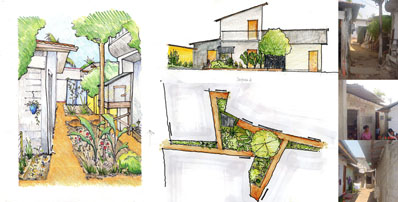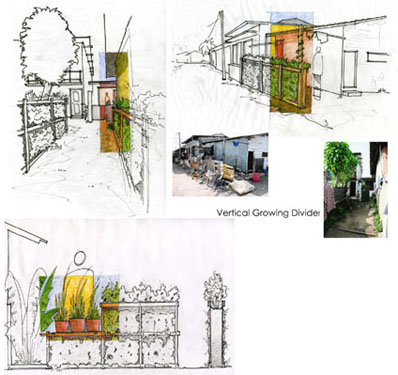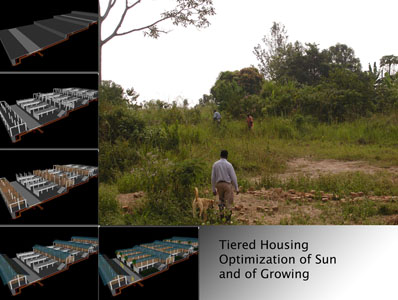The MCHG application package for the Holcim Foundation for Sustainable Construction's Award competition, demonstrates the innovative manner by which food production can be integrated into planning new settlements and upgrading existing marginalized neighbourhoods.

Land titles enabling maximum growing and participation drive the Kampala plan. Low-density permits shared productive gardens.
More Illustrations at the bottom.
Making the Edible Landscape:
Building Productive Neighborhoods
The act of growing in cities exists and has existed for millennia for various reasons, including food security. Our goal is to formalize its existence and to establish it permanently as an urban feature. With half of the world’s population living in informal settlements, upgrading and low-cost housing are two of the greatest challenges facing designers. For very low income people, the Making the Edible Landscape project provides neighborhoods where growing and living work symbiotically. Building a new settlement and upgrading two slums, at high and medium densities, enable us to integrate the house and garden approach to planning and design, as a permanent component of urban development. 3 very different neighborhoods will be built adapting to local conditions. In Kampala, Uganda, 200 families will form a new neighborhood, integrating private and community growing into its urban plan. In Rosario, Argentina, 250 families will benefit from the construction of a new settlement emphasizing a new vernacular of growing between street and home. Also in Rosario, 750 residents will participate in an upgrading that will leverage existing infrastructure for community growing, production and distribution. In Colombo Sri Lanka, 750 urban poor will benefit from an upgraded waterfront, turning flood-risk lands into productive zones and the introduction of community gardening through the recuperation of marginal or under-utilized lands. These 3 pilot sites are part of one global initiative. Partnering with municipalities, grassroots organizations and international agencies enables us to share local knowledge, innovative design ideas and urban agriculture practices globally. This design/build functions at various levels: field work and capacity-building is managed by local partners; global coordination, design proposal development, information sharing, project evaluation and monitoring is managed by an international staff; design and construction, the identification of under-utilized and marginal lands, the leveraging of municipal resources and the integration of UA in the construction of roadways and services are a collaborative effort. Sustainability is ensured through the use of local skills and material, community participation, data dissemination and the commitment of financial and in-kind resources by municipal partners. The project is a comprehensive model for future work in this area and its findings will be formally shared with over 200 city mayors and delegates at the World Urban Forum in 2006. This project will serve as a catalyst for change with regards to the pairing of growing and living as typical methods of creating and upgrading informal settlements throughout the world.
Ethical Standards and Social Equity
Half the world’s urban population lives in slums. The project provides the poorest with food security and quality shelter; it supports the UN Habitat millennium goal of cutting poverty in half by 2020 by proposing housing, agro-production and optimising uses of existing (marginal) lands. Local capacity building, community participation, and gender equality are fundamental at all project stages.
Quantum Change and Transferability
The project integrates urban agriculture (UA)—growing food and keeping livestock in cities—with housing and urban planning. UA is a sustainable generator for development, as it builds on local lifestyles and ecologies. Conventional urban design views landscape for its beauty and recreational benefits only. This project recognizes the productive and utilitarian values of landscape design, and how growing can co-exist with quality urban living. Working with 3 city teams on 3 continents, the project will upgrade or construct nearly 2000 houses. The results will be presented to 200 mayors at the 2006 World Urban Forum, thus seeking to replicate results elsewhere. The project is innovative for reconsidering urban land-use, collaborative design and community-based construction methods.
Contextual Response and Aesthetic Impact
Instead of creating more low-income urban housing projects resembling “concrete jungles,” this project builds on a history of using concrete as an effective means to express individual needs at the household scale. Participatory design enables residents to build productive and pleasing homes. The dual need for economical production and a high quality aesthetic transcends boundaries of culture and social standing. In poor areas that lack formal design input, architecture, design, planning and environmental/agricultural specialists and students have joined local grassroots organizations to upgrade or construct new income-producing homes and gardens in a sustainable manner, improving the physical environment; homes, gardens, plazas and streetscapes thus created can express individuality.
Ecological Quality and Energy Conservation
Creating local, rather than distant food sources is essential for food security and energy conservation. Proximity to the home also spurs alternative uses of small spaces, walls, rooftops or marginal lands; it favours hands-on approaches to water conservation, recycling, increased soil quality with less chemical fertilizers and pesticides, social integration and sharing of food/health knowledge.
Economic Performance and Compatibility
The project advocates incremental, self-build structures to be realized over time, affordable to the poorest clients: a porch may thus be built before an enclosed structure. The project uses growing as a catalyst for income-generation and construction, thus replaces the traditional work-live distinction, linking home-building with income-generation, at a scale commensurate with local means.







